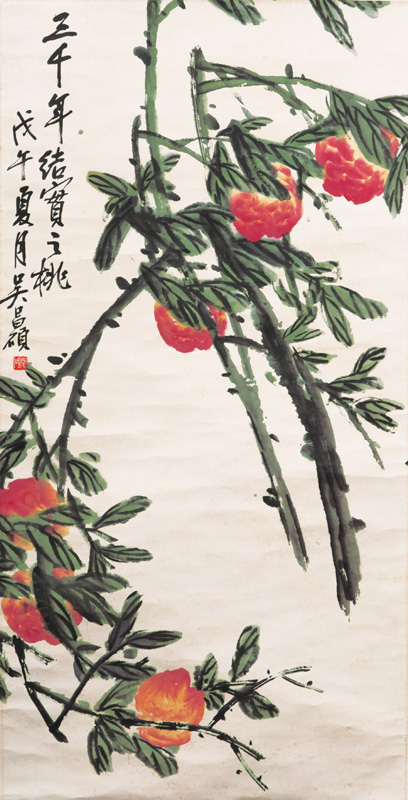Longevity Peaches
WU Changshuo 1844 - 1927, attr.

Lot-No. 310
China, 1918. Hanging scroll. Ink and colour on paper, inscribed in Chinese in the upper left corner, sign. 'Wu Changshuo' and dat. 'wuwu' year (1918). Artist's seal. 95 x 48 cm. - The inscription refers to the legendary longevity peaches: 'The peach fruit, which ripened 3000 years'. These peaches grew in the orchard of goddess Xiwangmu in the Kunlun mountains. - Prov.: From the coll. of a renowned German expert for Chinese art and culture, acquired in China directly after the cultural revolution. - Chinese painter and scholar, one of the main representatives and innovators of Chinese painting during the late Qing-dynasty, born into a scholarly family, extensively studying the traditional art of Chinese seal carving, which WU later combined with his calligraphic style, his work influenced the following generation of artists (e.g. QI Baishi and PAN Tianshou).
Changshuo WU, zugeschr.: Longevity Peaches
WU Changshuo 1844 - 1927, attr.
Longevity Peaches
Lot-No. 310
China, 1918. Hanging scroll. Ink and colour on paper, inscribed in Chinese in the upper left corner, sign. 'Wu Changshuo' and dat. 'wuwu' year (1918). Artist's seal. 95 x 48 cm. - The inscription refers to the legendary longevity peaches: 'The peach fruit, which ripened 3000 years'. These peaches grew in the orchard of goddess Xiwangmu in the Kunlun mountains. - Prov.: From the coll. of a renowned German expert for Chinese art and culture, acquired in China directly after the cultural revolution. - Chinese painter and scholar, one of the main representatives and innovators of Chinese painting during the late Qing-dynasty, born into a scholarly family, extensively studying the traditional art of Chinese seal carving, which WU later combined with his calligraphic style, his work influenced the following generation of artists (e.g. QI Baishi and PAN Tianshou).


